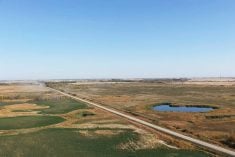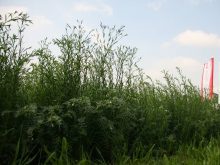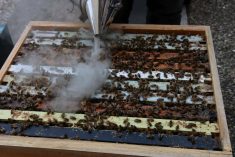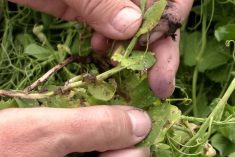A provincial insect management specialist says grasshoppers could pose a significant challenge for farmers in Saskatchewan this season.
During a June 14 webinar offering advice on managing grasshopper populations, James Tansey of Saskatchewan Agriculture said, “we’ve got a bit of a perfect storm for grasshoppers this year.”
According to Tansey, warm and dry conditions in the province last summer resulted in a rapid onset of adult grasshoppers, which laid a lot of eggs. Then, warm conditions and timely rains this spring produced a lot of green feed for young grasshopper nymphs to feed on when they emerged from the ground.
Read Also

BASF donates seed, inputs to community growing projects
Growers or retailers interested in nominating a community project for the Fields of Purpose program in 2026 can contact their local BASF representative.
Tansey said one of the first steps for control is to identify what type of grasshopper is present. While 85 species of grasshopper have been identified in Western Canada, most are non-pest species and only four are what Tansey called “problematic” for most farmers.
Typically, non-pest grasshoppers have wings before late June with brightly coloured hind wings and are noisy flyers.
“A good mantra is, ‘if it has wings in the spring, it’s not a pest,’ ” Tansey said.
The most common pest-type grasshoppers in Saskatchewan are migratory (Melanoplus sanguinipes), Packard’s (Melanoplus packardii) and two-striped (Melanoplus bivittatus).

Migratory grasshoppers are a dark grayish brown tinged with red, with a yellowish belly and black bands on their hind legs. Host plants include forbs, grasses, wheat and barley.
Packard’s grasshoppers are gray to dark yellow, have two light-coloured stripes behind their eyes and blue tibias on their hind legs. They feed on vegetables and small grains but prefer legumes.
Two-striped grasshoppers have two pale stripes extending from their eyes to the tip of their forewings and a black stripe on their hind femur. They will feed on alfalfa as well as other crops such as cereals.

Monitoring methods
Tansey said there are two recommended methods for monitoring grasshopper populations in a field and determining numbers in relation to economic thresholds.
The first is the transect method in which an individual walks a 10-metre transect or path and uses a one-metre stick to estimate the number of insects in that area. The process should be repeated five times with the total number of insects divided by 50.
The second recommended method is sweep sampling in which an individual uses a net and takes four, 180-degree sweeps at different spots, repeated in at least five locations. It’s important not to collect any soil in the net.
While the sweep sampling technique takes time to perfect, Tansey said, it allows the person doing the sweep to hit multiple populations much quicker than doing a walking survey.
So, what if you discover pest-type grasshoppers in the field?
Tansey advises people to consult the 2023 Guide to Crop Protection for current information on products registered and marketed for specific crops. He warned against going off-label when using insecticides to control grasshoppers.
“Do not go off-label. I’ve heard reports about some off-label applications, and you can really get yourself into trouble with that,” Tansey said.
“If it has grasshopper on the label, you can pretty much take that to the bank that it’s going to be efficacious if you follow the label directions. If it’s registered, there’s a good reason for it. If it’s not, there’s also a good reason for it.”
Tansey also recommended that growers consider maximum residue limits of any products and follow recommendations on product labels.
Insecticide options
Tansey said Group 3 insecticides (synthetic pyrethroids) are effective against young grasshoppers. He noted examples for wheat include:
- Decis 100 EC and several other deltamethrin products
- UP-Cyde and Ship (cypermethrin)
- Silencer, LaBamba and Zivata (lambda-cyhalothrin)
Tansey said one exception in Group 3s is Permethrin insecticide, which has low efficacy against two-striped grasshoppers. He also cautioned against using lambda-cyhalothrin products on crops intended for animal feed, as some buyers may not accept it. The efficacy of most Group 3s decreases with very warm temperatures.
Group 28 insecticides, also known as diamides, are generally effective against adult grasshoppers, Tansey said. That includes products such as Coragen and Coragen Max. However, it may take several days for the insects to die after spraying.
“What freaks some people out a little bit about the Group 28s is they’re not knock-down insecticides like some of the other ones,” said Tansey. “The animal is still going to be alive, but it’s not feeding or it’s feeding much less.”
Tansey noted Group 1B products, known as organophosphates, are also effective against adult grasshoppers. These are some of the oldest chemistries available, some dating back to the 1930s.
He said some of the more popular Group 1Bs include malathion products, whose efficacy improves with warmer temperatures, and Lagon 480 E, which provides about eight days of residual efficacy.
Growers should be aware that Group 1B products containing chlorpyrifos, such as Lorsban, can only be applied until the end of this season, as they will be deregistered and unavailable for use in Canada as of Dec. 10.
Alternative solutions
Biopesticide baits, which are ingested by grasshoppers, are an alternative to insecticides. Tansey said Nolo Bait, containing naturally occuring Nosema locustae spores, is one of the more popular ones. It should be applied to fields when there is no above-ground harvestable food present.
Eco Bran, a wheat bran infused with carbaryl insecticide, is another effective bait that can “kill a large number of grasshoppers in relatively short order,” said Tansey. It cannot be used in crops such as corn, alfalfa, clover, wheat, oats, barley, rye and sweet lupins.
There are cultural control methods to protect against grasshoppers. Although they generally won’t provide knock-down or total mitigation of grasshopper damage, Tansey said, they can significantly reduce damage.
Cultural control options include:
- Early seeding produces more resilient crops capable of withstanding more grasshopper damage.
- Add crops that include non-preferred hosts, such as oats and peas, to the rotation.
- Tillage removes early green plants when grasshoppers are still in the nymph stage, effectively starving the insects.
- Trap strips lure grasshoppers to areas away from harvestable crops.
Tansey cautioned that growers shouldn’t become complacent even if conditions appear less than ideal for future grasshopper development this summer.
“Everything for next year depends on the conditions in July,” he said. “There are some factors that could contribute to their mortality … (like) if we get the onset of very cool, wet conditions.”
Tansey added if warm, dry conditions continue in Saskatchewan through the summer and grasshopper numbers remain high, “we could be looking at more trouble for next year, barring a very cool, wet spring and early summer next year.”
















